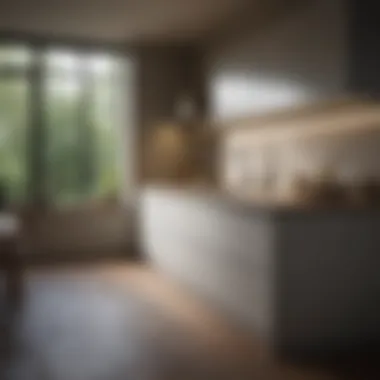Understanding Average Kitchen Cabinet Height for Design


Intro
Importance of Cabinet Height
The height of kitchen cabinets should cater both to personal comfort and the layout of the kitchen. If cabinets are too high for a user, it can lead to discomfort during cooking or cleaning. Conversely, if they are too low, they may not utilize the space effectively, potentially leading to storage issues. Thus, exploring the average height of kitchen cabinets provides essential insights for optimizing the kitchen experience.
Design Inspirations
The appearance of kitchen cabinets is crucial to the overall look of the kitchen. To ensure that the kitchen reflects personal style, one must consider current design trends and color choices.
Trending Styles
Currently, popular styles include:
- Modern Minimalism: This style features clean lines and a sleek appearance, often using flat-panel cabinet designs.
- Rustic Charm: Wooden cabinets with a distressed finish give a farmhouse feel and an inviting atmosphere.
- Classic Elegance: Raised-panel doors and traditional moldings cater to those who prefer a more timeless look.
These styles dictate not only the aesthetics but also the functional aspects, including cabinet height, as some designs can make space look taller or more open.
Color Palettes
Color significantly influences not just the mood of the kitchen but also the perception of space. Some in-demand color palettes are:
- Whites and Off-whites: These colors create a bright and airy feeling and can make ceilings appear higher.
- Bold Colors: Deep blues or greens can add character and make the kitchen a focal point.
- Natural Wood Tones: These colors offer warmth and work well with many other kitchen elements.
Choosing the right color can affect how the height of cabinets is perceived, with lighter colors creating an illusion of more space.
Maintenance and Upkeep
Once the perfect kitchen is designed, maintaining its functionality and aesthetic appeal is crucial. Proper care can extend the life of cabinets and keep the kitchen looking fresh.
Seasonal Maintenance Checklist
To maintain cabinets, consider this checklist:
- Inspect hinges and adjust as needed.
- Clean surfaces with suitable products to avoid damage.
- Check for water damage, especially near sinks and dishwashers.
- Reapply protective finishes if necessary.
Cleaning and Organization Tips
A well-organized kitchen leads to efficiency. Here are some tips:
- Use Shelf Organizers: These can maximize space inside cabinets.
- Keep Frequently Used Items Accessible: Store them in lower cabinets or at eye level.
- Regularly Declutter: Dispose of items that are no longer used to keep spaces tidy.
The average height of kitchen cabinets typically ranges from 30 inches to 36 inches, with custom options available to fit individual needs.
Preface to Kitchen Cabinet Heights
When you determine the right height for kitchen cabinets, you are not only considering the functionality but also the overall design of your kitchen. Standard dimensions exist, but they may not accommodate everyone's needs. Therefore, evaluating the average height of kitchen cabinets becomes essential as it translates into ergonomic benefits that prolong comfort during usage.
Using a standard height of 36 inches for base cabinets and 30 inches for wall cabinets serves as a guideline, but this might not suit every user. Taller individuals may find standard heights too low. Conversely, shorter individuals may struggle with cabinets that are positioned too high. This delicate balance between user preference and functionality must be evaluated comprehensively.
Additionally, the style and layout of your kitchen may dictate specific height requirements. For instance, a minimalist kitchen design might necessitate different measurements from a traditional style. Ultimately, knowing the average heights can help homeowners and design enthusiasts make informed choices, laying the groundwork for a workspace that is both practical and tailored to unique preferences.


"Selecting the right kitchen cabinet height is a blend of personal preference, ergonomic considerations, and aesthetic choices."
Exploring this topic allows readers to assess their needs accurately, ensuring that their kitchen serves its intended purpose without compromising on comfort or style.
Standard Dimensions of Kitchen Cabinets
Understanding the standard dimensions of kitchen cabinets is crucial for anyone looking to design or remodel a kitchen. Standard sizes play a significant role in not only aesthetic appeal but also functionality and usability. When cabinets are properly sized, they can enhance the flow of the kitchen, making the space more efficient for cooking and other tasks.
Base Cabinets
Base cabinets typically height is 34.5 inches without a countertop. This height allows for an optimal working space for most adults. If you include the countertop, the total height reaches about 36 inches. This dimension is important for several reasons:
- Ergonomic Considerations: A height of 36 inches provides a comfortable working level for food prep. Users do not need to bend too much, reducing strain on the back.
- Storage Compatibility: Base cabinets are designed to hold standard kitchen appliances and commonly used items. Understanding their height ensures there's enough space to accommodate these objects.
- Uniform Look: Staying within standard dimensions helps create a cohesive look in the kitchen. When base cabinets are too tall or short, it can disrupt the overall design.
Wall Cabinets
Wall cabinets come in varied heights, usually ranging from 30 to 42 inches. The installation height can be tailored based on ceiling height and the desired reach of the user. Key aspects include:
- Accessibility: Wall cabinets should be installed such that the most frequently used items are within easy reach. For average users, keeping them around 18 inches above the countertop facilitates ease of access.
- Visual Balance: Wall cabinets contribute to the overall aesthetics of the kitchen space. The height should match the base cabinets to create a balanced visual flow.
- Personalization: With varying heights available, homeowners can select wall cabinets that suit their specific needs, if standard heights do not fit well.
Balancing wall cabinet height is crucial for both design and functionality. This ensures that the kitchen is not only beautiful but also practical for daily use.
"Standard dimensions set a foundation upon which a functional and stunning kitchen is built."
Being aware of standard dimensions assists homeowners, interior designers, and others in creating better kitchen spaces tailored to their unique needs, ensuring both aesthetic and functional success.
Factors that Influence Cabinet Height
User Height and Ergonomics
User height is a critical determinant in establishing cabinet heights. When cabinet heights are tailored to the users, they can significantly improve daily kitchen tasks. For instance, individuals of shorter stature may find standard counter heights inadequate. This can lead to inconvenience, as they might struggle to reach items stored above or on high shelves.
Ergonomics indicates that upper cabinets should ideally be within a comfortable reach zone. American National Standards Institute (ANSI) suggests a range of 50 to 70 inches for the height of wall cabinets. Understanding these ergonomic guidelines helps create a comfortable workspace that minimizes strain. Homeowners should assess their height and the average height of their family members to determine appropriate cabinet placement.
Ceiling Height Considerations
Ceiling height remarkably affects the design and functionality of kitchen cabinets. While standard ceiling heights traditionally range from 8 to 9 feet, more modern homes often have higher ceilings. In spaces with elevated ceilings, cabinets can exceed the standard height, maximizing storage. For instance, installing cabinets that reach up to the ceiling not only utilizes vertical space effectively but also creates a seamless visual appearance.
Additionally, the height of wall cabinets should respect proper clearance guidelines, typically leaving 18 inches between the countertop and the bottom of the wall cabinet. This ensures that users can function efficiently without feeling cramped. Higher ceilings also open the possibility for decorative elements above cabinets, enriching the kitchen's aesthetics.
Style of Kitchen Design
The style of kitchen design is paramount in determining suitable cabinet heights. Various design trends influence cabinet dimensions, emphasizing functionality as well as style. Open-concept kitchens often favor taller cabinets for a streamlined look, while traditional designs may opt for lower heights to create a cozier feel.
Flexible kitchen design styles include:
- Modern Minimalist: Preferring tall, slim cabinets to reduce clutter.
- Rustic: Using shorter, bulkier cabinets to offer a homely ambiance.
- Industrial: Integrating mixed heights for visual interest.
Each of these styles presents its unique requirements for cabinetry that provide both visual and functional satisfaction. Homeowners should align cabinet heights with the kitchen’s overall style, creating harmony among all elements.
"Designing with purpose intricately links ergonomics, user needs, and aesthetic aspirations."
Custom Kitchen Cabinets


Custom kitchen cabinets are a crucial component when considering the overall height and functionality of your kitchen space. Unlike standard cabinets, which can sometimes create limitations, custom cabinets allow homeowners to craft solutions that suit their specific needs and preferences. This customization not only extends to the height of the cabinets but also encompasses width, depth, and design aspects that align perfectly with the unique space and usage requirements.
One of the main advantages of custom kitchen cabinets is the ability to create a tailored fit. Many kitchens have non-standard dimensions or architectural features, such as ceiling slopes or awkward corners. With custom cabinetry, these challenges are met with innovative design, ensuring that every inch of space is utilized effectively. This specificity can lead to maximized storage solutions and improved accessibility.
Benefits of Customized Height
The height of kitchen cabinets can greatly influence comfort and usability. Customized heights can enhance ergonomic access, minimizing hazards and maximizing convenience. Here are some of the key benefits of customizing cabinet height:
- Personalized Reach: Custom heights cater to the primary users’ heights, ensuring that both base and wall cabinets are easily accessible. This is especially important in multi-user households.
- Improved Storage: Custom cabinets can extend the height of cabinets to the ceiling, offering additional storage space for items that are not used frequently, thus keeping a clutter-free kitchen.
- Aesthetic Appeal: Tailored dimensions allow for a more cohesive and visually pleasing design. This attention to detail can elevate the overall look of the kitchen, making it feel intentional rather than an afterthought.
Ordering and Designing Custom Cabinets
The process of ordering and designing custom kitchen cabinets involves several steps to ensure the final product meets your expectations. Here are some important considerations:
- Consultation with Professionals: Start with a meeting with a kitchen designer who specializes in custom cabinetry. They possess insights that can help you visualize the final design and function.
- Measurements: Accurate measurements of the space are crucial. Make sure to record measurements for height, width, and depth of potential cabinet locations. This ensures that the cabinets will fit snugly in your kitchen.
- Material Choices: Decide on the materials for your cabinets. Options range from solid wood, medium-density fiberboard, to plywood. Each material offers different durability and aesthetic qualities.
- Design Preferences: Choose your cabinet style, finish, and hardware. The design should match the overall theme of your kitchen while also being practical for daily use.
- Review and Adjustments: After the initial designs are created, review them thoroughly. Discuss any adjustments needed based on your preferences and practical usage.
- Installation: Once finalized, the custom cabinets will be constructed and installed. Proper installation is key to achieving the desired functionality and aesthetics.
With these components in play, custom kitchen cabinets can significantly enhance both the style and utility of your kitchen, facilitating a more organized and enjoyable cooking environment.
Ergonomic Guidelines for Cabinet Heights
The ergonomic guidelines for cabinet heights play a crucial role in ensuring that a kitchen is not just aesthetically pleasing but also functional. Proper cabinet height can significantly impact comfort and efficiency in daily tasks. By understanding ergonomic principles, homeowners can design their kitchens in a way that minimizes physical strain and enhances usability.
Reach Zones in Kitchen Design
In kitchen design, reach zones are critical for ensuring that all items are easily accessible without causing undue stress to the body. The concept of reach zones divides the kitchen space into areas depending on how far a user can comfortably stretch to retrieve items.
- Primary Reach Zone: This is typically between 15 to 20 inches from the front edge of the countertop. Items stored at this height are quickly reachable and should contain frequently used utensils or cooking tools.
- Secondary Reach Zone: Extending from 20 to 30 inches, this zone is slightly less accessible but can still be used for items that are needed often yet not in daily use.
- Tertiary Reach Zone: Anything above 30 inches falls into this zone. It is often used for infrequently accessed items, thereby making it acceptable to store them the higher they are.
When designing kitchen cabinetry, it's essential to recognize how these zones interact with different heights. Adjusting cabinet height to align with these zones enhances workflow and reduces awkward movements.
Creating an Accessible Kitchen Space
Creating an accessible kitchen goes beyond simply complying with standard heights. This involves consideration of all users, including those with physical limitations. An accessible kitchen must account for height variations as well as the reach capabilities of all individuals.
- Lowered Base Cabinets: For some users, it might be beneficial to lower the base cabinet height slightly to allow for easier access. Typically, base cabinets are around 34-36 inches high, but adjusting this according to user needs can significantly impact usability.
- Adjustable Shelving: Incorporating adjustable shelves in wall cabinets can provide flexibility. Users can modify the height according to their preference and reach, allowing easy access to all kitchen items.
- Lighting and Visibility: Good lighting plays a role in accessibility. Well-lit spaces enable individuals to locate and see items on higher shelves more easily. Proper placement of lights can guide users throughout the kitchen, further enhancing effectiveness.
"A well-planned kitchen not only focuses on aesthetics but also incorporates functional designs that adhere to ergonomic principles. This ensures comfort for all users."
Impact of Cabinet Height on Kitchen Functionality
The cabinet height significantly shapes the overall functionality of a kitchen. This aspect extends beyond mere aesthetics; it encompasses efficiency, accessibility, and user experience. When cabinets are at appropriate heights, they optimize storage and aid in a smoother workflow. Conversely, if cabinet heights are miscalculated, it can lead to frustrations and inefficiencies. Understanding these implications can help homeowners and designers to create a kitchen that not only looks appealing but also operates effectively.
Storage Efficiency
Storage is a primary function of kitchen cabinets. The height of cabinets directly influences how effectively space is utilized. If wall cabinets are too high, they may lead to underutilization of the upper storage areas. It becomes challenging to reach items, resulting in a tendency to stack less-used items on higher shelves, while frequently used items remain at lower elevations.
To enhance storage efficiency, consider the following:
- Maximize vertical space: Utilizing vertical height effectively allows for more storage without taking up additional floor space. The average height of wall cabinets, typically around 30 to 42 inches, can be adjusted based on the ceiling height and ease of reach.
- Categorize items: Store frequently used items at shoulder or eye level. Less used items can be placed higher or in deeper cabinets.
- Incorporate pull-down shelves: These innovations can bring stored items within reach, making high spaces accessible without strain.
Effective storage is not only about putting things away. It is about making sure everything is easily accessible.
Workflow and Movement
The height of kitchen cabinets can also significantly affect workflow and movement within the space. Think of it like a dance; every movement should feel natural and effortless. When cabinets are positioned correctly, it allows for a logical flow between different work zones, such as cooking, prep, and cleaning areas.
Some aspects to consider include:


- Ease of access: Cabinets at the right height reduce the need for awkward stretching or bending. The average base cabinet height stands around 36 inches, a design that accommodates most countertop tasks comfortably.
- Traffic flow: Proper cabinet height encourages efficient movement in the kitchen. A well-designed space allows for enough room to navigate around cabinet doors and drawers without obstruction.
- Storing kitchen tools: Frequently utilized tools should be accessible within arm's reach. Upper cabinets should not impede reaching for pots, pans, and tools essential for cooking.
By contemplating these factors, one can enhance the functionality of their kitchen, making sure that it not only appears tailored to their needs but also operates smoothly.
Trends in Kitchen Cabinet Design
The design of kitchen cabinets is in constant evolution, influenced by changing consumer preferences, lifestyle needs, and advancements in materials and technology. Understanding these trends is crucial for homeowners and designers alike, as it allows for the integration of current aesthetics and functionalities that enhance both the appearance and usability of a kitchen space.
As kitchens have transformed from mere cooking areas to multi-functional hubs, the relevance of cabinet height has gained prominence. Proper height not only impacts the overall aesthetic appeal but also significantly affects the kitchen's functionality. Kitchen cabinets must align with user needs while offering ample storage and easy access to utensils and appliances. Keeping abreast of these trends can lead to better decision-making and ultimately more satisfying results when remodeling or building a kitchen.
Height Trends in Modern Kitchens
In modern kitchen designs, the typical height for base cabinets is around 34.5 inches. However, recent trends show a growing preference for higher base cabinets. These can reach heights of 36 inches or even more in some contemporary designs. The increase in base cabinet height often aligns with the taller countertop heights preferred in many modern homes, addressing the needs of users who request a more comfortable and ergonomic work surface.
Another trend is the layering of cabinet heights. Wall cabinets are often installed at varying heights to create visual interest while catering to practicality. This can include lower wall cabinets for frequently used items or higher placements for less accessible spaces like corners. Integrating open shelving at various heights has also surged in popularity, allowing for easier access and a more personalized touch.
Influence of Minimalism on Cabinet Heights
Minimalist design encourages simplicity and functionality in kitchen spaces. This approach often results in a reduction of clutter through sleek cabinetry with clean lines. In these designs, cabinet heights may be standardized, but with strategic variations to maintain an uncluttered appearance. It is common to see higher wall cabinets that reach close to ceiling height in minimalist kitchens, providing abundant storage without overwhelming the visual space.
Furthermore, the minimalism trend frequently emphasizes the use of fewer materials and colors in kitchen cabinets, leading to uniform heights across various types. This approach can create a sense of harmony and order. Homeowners may opt for cabinets in higher finishes, which draw the eye upward, contributing to a feeling of spaciousness in the kitchen. The focus is not just on the height but on the overall balance and aesthetic integration within the space.
"Cabinet height is a crucial factor in modern kitchen design, influencing both functionality and aesthetic appeal. Understanding current trends is key for achieving a well-balanced kitchen layout."
Epilogue: Setting the Right Height for Your Kitchen Cabinets
Selecting the appropriate height for kitchen cabinets is a critical decision during the design and renovation process. The proper height not only ensures aesthetic harmony in your kitchen but also significantly enhances functionality.
When it comes to base cabinets, which typically stand at 36 inches, this dimension is established to accommodate a wide range of users while providing comfort during daily activities such as cooking and cleaning. For wall cabinets, standard heights around 30 inches from the counter allow easy access to frequently used items while maintaining an open feel in the kitchen space.
Benefits of Adjusting Heights
Customizing cabinet heights can cater to specific user needs. Individuals who are taller may benefit from slightly raised base cabinets or higher wall units, promoting better ergonomics and reducing strain on the back. On the other hand, shorter users might prefer lower configurations to ensure all kitchen essentials are within reach.
Keep in mind, the right height can make your kitchen not only more functional but also more enjoyable to use.
Additionally, considering the entirety of your kitchen's design is vital. The ceiling height, overall kitchen layout, and design style influence the effectiveness of cabinet height selections. If you have a higher ceiling, raising cabinets can create a more elegant look while allowing for additional storage. Conversely, in compact spaces, going with standard heights can maintain an airy feel without overwhelming the design.
Overall Considerations
When deciding on cabinet heights, here are some specific elements to consider:
- User Preferences: Each person has unique preferences regarding what feels comfortable and accessible.
- Kitchen Workflow: Height impacts how you move within your space. Ensure the layouts consider ergonomics and movement.
- Aesthetic Balance: Cabinet height needs to align with overall kitchen design. Ensure it complements other design elements effectively.
Frequently Asked Questions (Commonly Asked Questionss)
The section of Frequently Asked Questions serves an important role in this article as it provides clarity and addresses common concerns that homeowners and design enthusiasts may have regarding kitchen cabinet heights. Understanding the average dimensions and measurement techniques can significantly influence kitchen design decisions. By discussing specific queries, this section acts as a practical resource, guiding readers through essential considerations when planning their kitchen spaces.
What is the average height of base cabinets?
Base cabinets are a fundamental component of any kitchen. The average height of base cabinets typically is 34.5 inches. This standard height allows for a comfortable workflow, accommodating most countertop surfaces set at around 36 inches when including the thickness of the countertop. It is vital to measure precisely according to your space, especially if you have unique requirements.
Many factors influence the height choice for base cabinets. For instance, if the user is taller or shorter than average, adjustments might be necessary to create an ergonomic workspace.
It is crucial to keep in mind that the height of the base cabinets directly affects the usability of countertops and the overall kitchen flow.
How do measure for custom cabinets?
When considering customized cabinets, accurate measurement is essential. Here are the steps to measure effectively:
- Use a Level: Ensure your floor is level before measuring.
- Measure Height: Measure from the floor to the ceiling, accounting for any potential obstructions.
- Measure Width: Measure the available space where the cabinet will be installed. Include gaps for expansion and contraction due to humidity.
- Depth Considerations: Standard depth for base cabinets is generally 24 inches. When measuring for custom options, think about what depth suits the kitchen layout.
- Documentation: Write down all measurements clearly, and consider creating a visual layout or sketch of your kitchen design.
By following these guidelines, you can ensure your custom cabinets not only fit perfectly but also enhance your kitchen's overall functionality.







